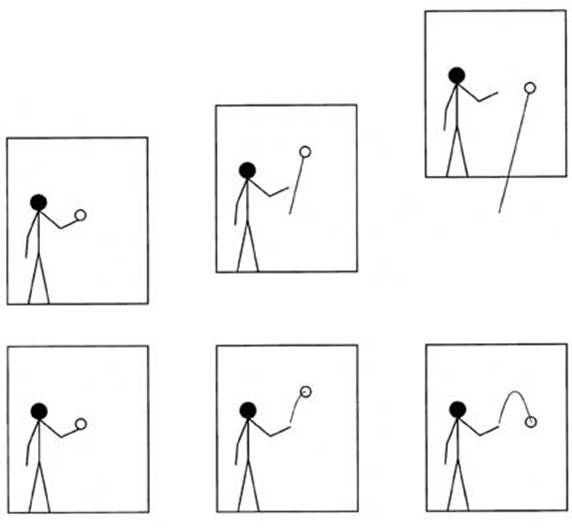A B
C
D E F
C. Gravity and Acceleration
One of the more significant clues that Einstein noted early
in his investigation involved a simple way to produce gravity where it might not
be expected to exist.
Imagine being inside an elevator and tossing a ball from
one hand to the other. The ball goes up, the ball comes down, over and
over-nothing special there. But now imagine
being in the same elevator floating somewhere in outer space, away from the
earth or any other large celestial bodies. Tossing the ball there produces
quite a different result: instead of rising in an arc, getting slower near
the top, and then speeding up as it falls, the ball moves in a straight line
without slowing down at all. Instead of falling into your other hand, the
ball just moves straight toward the top of a wall or the ceiling, and bounces
around up there in the corner a few times and then comes back toward you in
another straight line. We see in this a demonstration of Isaac Newton's
first law of motion-the law of inertia: things at rest tend to remain at
rest, while things in motion tend to continue moving at a constant speed and
direction, unless some force acts on them to change their rest or motion.
Now
imagine this "space elevator" beginning to move, as shown in the top
row of Figure 2. Suppose it accelerates "upward" at a steady
rate, getting faster and faster each second. Now when you toss the ball,
from the perspective of someone outside the elevator who isn't accelerating, the
ball still moves in a straight line, but you and the elevator floor begin to
overtake it as the elevator continues to gather speed. From your
perspective, it turns out that the ball rises at first but slows down, then
falls toward your other hand. The steady acceleration produces the same
sort of effect as a gravitational field. In fact, the similarity is so
great that, if you couldn't see outside the elevator and had no idea where you
were, and the acceleration was one g (9.8 meters per second per second),
you'd have no way to tell that you weren't on earth. Any experiment you
could do on the elevator would give results consistent with your being in an
ordinary gravitational field.

Figure 2. Top row:
"elevator" accelerating "upward" in zero gravity, seen at
three different times. Tossed ball, as seen from outside the elevator,
moves at constant velocity, as indicated by the straight line. Bottom
row: view from within the elevator. From this perspective, the
tossed ball undergoing the same motion is seen as rising and falling, just as it
would in a uniform gravitational field.
As the elevator accelerates upward, all objects floating
around inside will appear to fall with the same downward acceleration, no matter
what masses the objects have, provided they have enough mass that the air in the
elevator doesn't noticeably inhibit their motion. The action of gravity is
exactly the same: as long as gravity is the only thing influencing their
motion, light objects will fall just as quickly as heavy ones. (When they
don't, it's because the buoyancy and viscosity of the air affect light objects
more. Gravity by itself doesn't treat light and heavy objects differently,
as we learn from experiments with objects falling in vacuum. One such
experiment, using a feather and a hammer, was even done once on the moon.
In the absence of air, the feather fell right alongside the hammer when both
were dropped together.)
What we in the elevator would see as objects falling under
the influence of gravity, someone who wasn't accelerating like the elevator
would see as objects moving at constant speeds in straight lines, just as the
law of inertia describes. Put another way, the spacetime path of each
"falling" object is a straight line, even though the paths look curved
from our perspective in the elevator; in spacetime, our own path, accelerating
as we are, is the curved one.
A lesson Einstein grasped from contemplating such
"thought-experiments" is that objects acting under the influence of
gravity alone might be following the straightest possible paths in
spacetime. If spacetime is curved, the straightest possible path for an
object may be curved itself, just as the straightest possible connection between
two points on the earth's equator is a segment of the curved equator. This
suggests a way to generalize the law of inertia: while the paths of
undisturbed objects are straight lines in uncurved spacetime, the paths in
curved spacetime are the straightest possible lines, with the only bends being
those necessary to follow the curvature of spacetime itself.
Einstein saw that the curvature of spacetime might provide
an explanation for the "ordinary" gravity seen with all objects.
If the spacetime near a massive object were curved, any other object passing by
would move along whichever curved spacetime path was the straightest one in
front of it, as long as gravity was the only influence on the motion.
Once Einstein understood this, it remained for him to
figure out what determined the spacetime's exact curvature. Different
curvatures would result in different paths for objects in spacetime. What
curvature would result in the paths objects actually follow due to gravity?
(.....continued)
A B
C
D E F








